Top speed 357 km/h Wingspan 33 m Engine type Wright R-1820 Cyclone | Range 3,846 km Length 23 m First flight December 31, 1938 | |
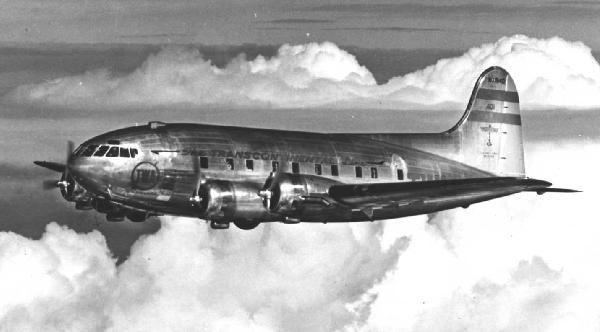 | ||
Unit cost 315,000–315,000 USD (1937) | ||
Boeing 307 stratoliner
The Boeing Model 307 Stratoliner was the first commercial transport aircraft to enter service with a pressurized cabin. This feature allowed the aircraft to cruise at an altitude of 20,000 ft (6,000 m), well above many weather disturbances. The pressure differential was 2.5 psi (17 kPa), so at 14,700 ft (4,480 m) the cabin air pressure was equivalent to an altitude of 8,000 ft (2,440 m). The Model 307 had capacity for a crew of six and 33 passengers. The cabin was nearly 12 ft (3.6 m) across. It was the first land-based aircraft to include a flight engineer as a crew member (several flying boats had included a flight engineer position earlier). In addition to its civilian service it was also flown as the Boeing C-75 Stratoliner by the United States Army Air Forces, who used it as a long-range cargolift aircraft.
Contents
- Boeing 307 stratoliner
- Development and design
- C 75 conversion
- Operational history
- C 75
- Variants
- Civilian operators
- Military operators
- Accidents and incidents
- Surviving aircraft
- Specifications Boeing 307
- References
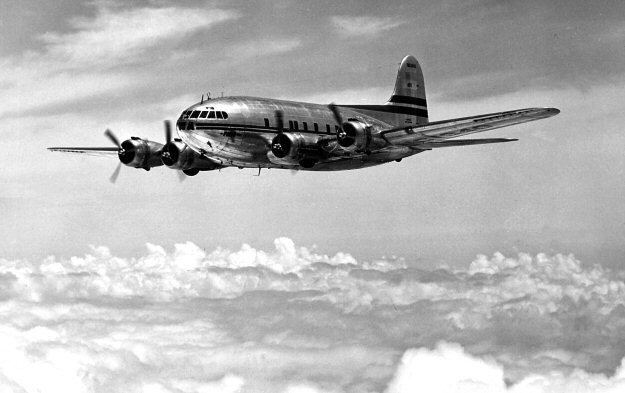
Development and design
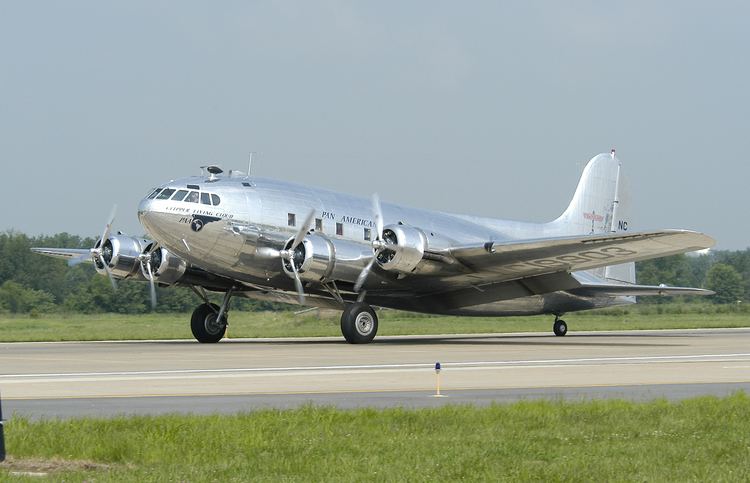
In 1935 Boeing designed a four-engine airliner based on its B-17 heavy bomber (Boeing Model 299), then in development, calling it the Model 307. It combined the wings, tail, rudder, landing gear, and engines from their production B-17C with a new, circular cross-section fuselage of 138 in (351 cm) diameter, designed to allow pressurization.
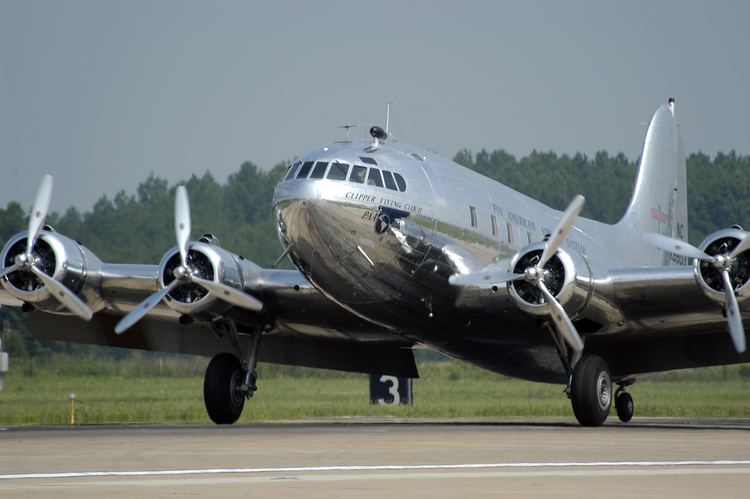
The first order, for two 307s (named Stratoliners), was placed in 1937 by Pan American Airways; Pan Am soon increased this to six, and a second order for five from Transcontinental & Western Air (TWA), prompting Boeing to begin production on an initial batch of the airliner.
C-75 conversion

At the time the United States entered World War II in December 1941, flying across oceans was a rare luxury. The war required government and military officials to do so and most four-engined long-range commercial aircraft, including Pan American Airways' 14 flying boats and TWA's five Boeing 307s, were pressed into service. Additional fuel tanks were added to give them the extra range required; once converted they were designated C-75 for military use. Before World War II ended their production, ten commercial 307s had been built. TWA flew domestic routes between New York and Los Angeles for 18 months until the Army purchased their Stratoliners for wartime use as long-range, transatlantic transports for various VIPs or critical cargo. TWA converted their 307s to military service in January 1942, and its Intercontinental Division (ICD) then operated these C-75s under contract to the Army's Air Transport Command (ATC) until July 1944. These were the only U. S. built commercial aircraft able to cross the Atlantic with a payload until the arrival of the Douglas C-54 Skymaster in November 1942.
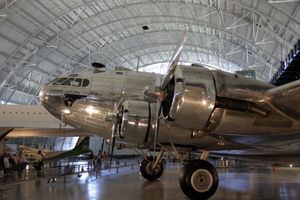
Conversion to the C-75 included removal of the pressurization equipment to save weight, removal of the forward four (or five) of nine reclining seats along the port side, and alteration of the two forward Pullman-like compartments (of four) starboard of the left-of-centerline aisle. Space was thus provided for crew requirements on extremely long flights and for the addition of five 212.5 U.S. gal (804 L; 177 imp gal) fuel tanks. The landing gear was strengthened, the maximum takeoff weight was increased from 45,000 to 56,000 lb (20,400 to 25,400 kg)), and the exterior painted military olive drab.
Operational history
The maiden flight of the first Boeing 307 Stratoliner (not a prototype, as it was planned to be delivered to Pan Am following testing and certification), registration NX 19901 took place from Boeing Field, Seattle on December 31, 1938. It crashed on March 18, 1939, while its performance with two engines inoperative on one wing was being demonstrated to representatives of KLM. When the engines were shut down, the pilot moved the rudder to maximum deflection to counter the resulting yaw. The Stratoliner then experienced rudder lock, where the control loads prevented the rudder from being re-centered. As a result, the 307 went into a spin and crashed. The ten people aboard, including KLM test pilot Albert von Baumhauer, Boeing test pilot Julius Barr, Boeing Chief Aerodynamicist Ralph Cram, Boeing Chief Engineer Earl Ferguson, and a TWA representative were killed. Subsequent wind tunnel testing showed that the addition of an extended dorsal fin ahead of and attached to the vertical tail prevented rudder lock. This was incorporated into the 307's rudder redesign, while also being incorporated in Boeing's rear fuselage redesign for their models "E" through "G" B-17 bomber.
The first delivery to a customer was to multi-millionaire Howard Hughes, who bought one 307 for a round-the-world flight, hoping to break his own record of 91 hours 14 minutes set from July 10–14, 1938 in a Lockheed 14. Hughes' Boeing Stratoliner was fitted with extra fuel tanks and was ready to set out on the first leg of the round-the-world attempt when Nazi Germany invaded Poland on September 1, 1939, causing the attempt to be abandoned. This 307 later had the extra fuel tanks removed, was fitted with much more powerful Wright R-2600 engines, and was transformed into a luxurious "flying penthouse" for Hughes, although it was little used, eventually being sold to oil tycoon Glenn McCarthy in 1949.
Deliveries to Pan Am started in March 1940, with TWA receiving its first 307 in April. TWA's Stratoliners flew three-stop flights between Los Angeles and New York while Pan Am's flew from Miami to Latin America. Ten 307s were built, three being delivered to Pan-Am (Clipper Flying Cloud, Clipper Comet, and Clipper Rainbow) and five to TWA (Comanche, Cherokee, Zuni, Navajo, and Apache) with one aircraft going to Hughes.
On the entry of the United States into World War II, Pan Am continued operating its Stratoliners on routes to Central and South America, but under direction of the Army Air Forces, while TWA's 307s were sold to the United States government, being designated Boeing C-75 and operated by the United States Army Air Forces (although normally still flown by TWA crews).
The Army returned its five C-75s to TWA in 1944, who sent them back to Boeing for rebuilding. Boeing replaced the wings and horizontal tail with those from the B-17G, while more powerful engines were fitted and the electrical system was replaced with one based on the B-29 Superfortress. Passenger capacity was increased from 33 to 38. The total rebuilding cost to TWA was $2 million; the five aircraft re-entered passenger service on April 1, 1945. Although TWA was committed to the larger and faster Lockheed Constellation, it kept the Stratoliners until April 1951.
TWA sold its Stratoliner fleet to the French airline Aigle Azur who used them on scheduled flights from France to North and Central Africa, and later to French Indo-China. These 307s were later transferred to Aigle Azur's Vietnamese subsidiary and were used by a number of airlines in South East Asia, with at least one aircraft remaining in commercial use until 1974.
Pan Am flew its unmodified 33-passenger Stratoliners between Miami and Havana until 1947, then sold them to small operators. One aircraft was purchased by the Haitian Air Force, being fitted as a Presidential transport for François "Papa Doc" Duvalier. This aircraft later returned to the U.S. and was purchased by the Smithsonian Museum.
C-75
Two main routes were flown: Washington, D.C., to Cairo across the South Atlantic, and New York to Prestwick, Scotland, across the North Atlantic. They often flew non-stop the 2,125 statute miles (3,415 km) between Gander, Newfoundland and Prestwick, Scotland in the north, and the 2,550 statute miles (4,100 km) between Natal, Brazil and Accra, Ghana in the south. After July 1942 a refueling stop at Ascension Island was an option in the south. In the north, stops at Iceland or Greenland were often necessary, especially flying westbound against the prevailing winds. As C-54s took over the Gander to Prestwick route, the C-75s operated a Marrakech-to-Prestwick service out over the Atlantic.
In April 1945, the five C-75s were returned to TWA, having been restored by Boeing and recertified by the CAA as SA-307B-1 civilian transports with their old registration numbers. TWA then restyled the interior cabin in two sections, ten seats forward and 28 aft.
Variants
Civilian operators
Military operators
Accidents and incidents
According to the Aviation Safety Network, the Boeing 307 was involved in eight hull-loss incidents for a total of 54 fatalities.
Surviving aircraft
The only surviving Boeing 307 Stratoliner (NC19903) is preserved in flying condition at the Smithsonian Museum's Steven F. Udvar-Hazy Center. On March 28, 2002, this aircraft crashed into Elliott Bay in Seattle, Washington, on what was to be its last flight before heading to the Smithsonian. Despite the incident, it was again restored, flown to the Smithsonian, and is now on display.
The fuselage of Howard Hughes' personal 307 also survives, although it has been converted into a houseboat. The aircraft was awaiting restoration at Fort Lauderdale international airport when it was severely damaged in a hurricane in the early 1960s, having been blown into a stand of trees after its tiedowns failed. The aircraft languished for nearly a year before being removed and longer still until later salvaged for its conversion into the house boat. The interior is notable for the original finishes and fitments added by Howard Hughes.
Specifications (Boeing 307)
Data from Jane's AWA 1942 (apart from wing area and loading)
General characteristics
Performance
